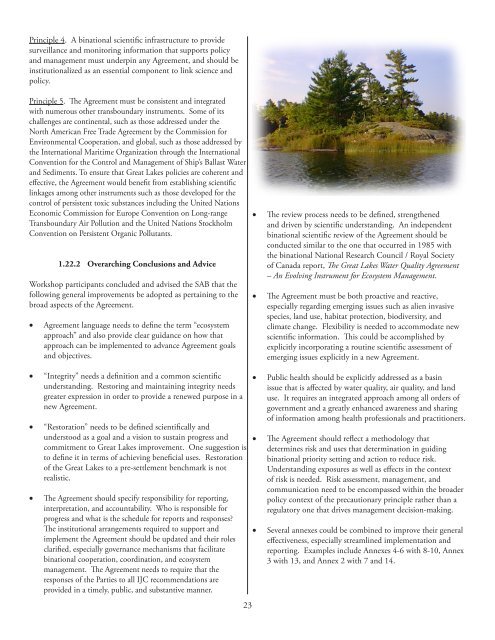Principles for Review of the Great Lakes Water Quality Agreement
Principles for Review of the Great Lakes Water Quality Agreement
Principles for Review of the Great Lakes Water Quality Agreement
Create successful ePaper yourself
Turn your PDF publications into a flip-book with our unique Google optimized e-Paper software.
Principle 4. A binational scientific infrastructure to provide<br />
surveillance and monitoring in<strong>for</strong>mation that supports policy<br />
and management must underpin any <strong>Agreement</strong>, and should be<br />
institutionalized as an essential component to link science and<br />
policy.<br />
Principle 5. The <strong>Agreement</strong> must be consistent and integrated<br />
with numerous o<strong>the</strong>r transboundary instruments. Some <strong>of</strong> its<br />
challenges are continental, such as those addressed under <strong>the</strong><br />
North American Free Trade <strong>Agreement</strong> by <strong>the</strong> Commission <strong>for</strong><br />
Environmental Cooperation, and global, such as those addressed by<br />
<strong>the</strong> International Maritime Organization through <strong>the</strong> International<br />
Convention <strong>for</strong> <strong>the</strong> Control and Management <strong>of</strong> Ship’s Ballast <strong>Water</strong><br />
and Sediments. To ensure that <strong>Great</strong> <strong>Lakes</strong> policies are coherent and<br />
effective, <strong>the</strong> <strong>Agreement</strong> would benefit from establishing scientific<br />
linkages among o<strong>the</strong>r instruments such as those developed <strong>for</strong> <strong>the</strong><br />
control <strong>of</strong> persistent toxic substances including <strong>the</strong> United Nations<br />
Economic Commission <strong>for</strong> Europe Convention on Long-range<br />
Transboundary Air Pollution and <strong>the</strong> United Nations Stockholm<br />
Convention on Persistent Organic Pollutants.<br />
1.22.2 Overarching Conclusions and Advice<br />
Workshop participants concluded and advised <strong>the</strong> SAB that <strong>the</strong><br />
following general improvements be adopted as pertaining to <strong>the</strong><br />
broad aspects <strong>of</strong> <strong>the</strong> <strong>Agreement</strong>.<br />
• <strong>Agreement</strong> language needs to define <strong>the</strong> term “ecosystem<br />
approach” and also provide clear guidance on how that<br />
approach can be implemented to advance <strong>Agreement</strong> goals<br />
and objectives.<br />
• The review process needs to be defined, streng<strong>the</strong>ned<br />
and driven by scientific understanding. An independent<br />
binational scientific review <strong>of</strong> <strong>the</strong> <strong>Agreement</strong> should be<br />
conducted similar to <strong>the</strong> one that occurred in 1985 with<br />
<strong>the</strong> binational National Research Council / Royal Society<br />
<strong>of</strong> Canada report, The <strong>Great</strong> <strong>Lakes</strong> <strong>Water</strong> <strong>Quality</strong> <strong>Agreement</strong><br />
– An Evolving Instrument <strong>for</strong> Ecosystem Management.<br />
• The <strong>Agreement</strong> must be both proactive and reactive,<br />
especially regarding emerging issues such as alien invasive<br />
species, land use, habitat protection, biodiversity, and<br />
climate change. Flexibility is needed to accommodate new<br />
scientific in<strong>for</strong>mation. This could be accomplished by<br />
explicitly incorporating a routine scientific assessment <strong>of</strong><br />
emerging issues explicitly in a new <strong>Agreement</strong>.<br />
• “Integrity” needs a definition and a common scientific<br />
understanding. Restoring and maintaining integrity needs<br />
greater expression in order to provide a renewed purpose in a<br />
new <strong>Agreement</strong>.<br />
• “Restoration” needs to be defined scientifically and<br />
understood as a goal and a vision to sustain progress and<br />
commitment to <strong>Great</strong> <strong>Lakes</strong> improvement. One suggestion is<br />
to define it in terms <strong>of</strong> achieving beneficial uses. Restoration<br />
<strong>of</strong> <strong>the</strong> <strong>Great</strong> <strong>Lakes</strong> to a pre-settlement benchmark is not<br />
realistic.<br />
• The <strong>Agreement</strong> should specify responsibility <strong>for</strong> reporting,<br />
interpretation, and accountability. Who is responsible <strong>for</strong><br />
progress and what is <strong>the</strong> schedule <strong>for</strong> reports and responses?<br />
The institutional arrangements required to support and<br />
implement <strong>the</strong> <strong>Agreement</strong> should be updated and <strong>the</strong>ir roles<br />
clarified, especially governance mechanisms that facilitate<br />
binational cooperation, coordination, and ecosystem<br />
management. The <strong>Agreement</strong> needs to require that <strong>the</strong><br />
responses <strong>of</strong> <strong>the</strong> Parties to all IJC recommendations are<br />
provided in a timely, public, and substantive manner.<br />
23<br />
• Public health should be explicitly addressed as a basin<br />
issue that is affected by water quality, air quality, and land<br />
use. It requires an integrated approach among all orders <strong>of</strong><br />
government and a greatly enhanced awareness and sharing<br />
<strong>of</strong> in<strong>for</strong>mation among health pr<strong>of</strong>essionals and practitioners.<br />
• The <strong>Agreement</strong> should reflect a methodology that<br />
determines risk and uses that determination in guiding<br />
binational priority setting and action to reduce risk.<br />
Understanding exposures as well as effects in <strong>the</strong> context<br />
<strong>of</strong> risk is needed. Risk assessment, management, and<br />
communication need to be encompassed within <strong>the</strong> broader<br />
policy context <strong>of</strong> <strong>the</strong> precautionary principle ra<strong>the</strong>r than a<br />
regulatory one that drives management decision-making.<br />
• Several annexes could be combined to improve <strong>the</strong>ir general<br />
effectiveness, especially streamlined implementation and<br />
reporting. Examples include Annexes 4-6 with 8-10, Annex<br />
3 with 13, and Annex 2 with 7 and 14.

















